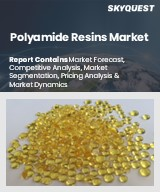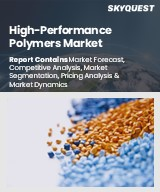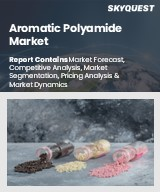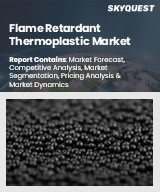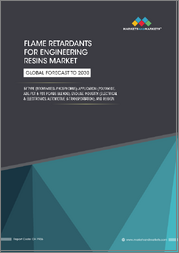
|
시장보고서
상품코드
1661040
세계의 바이오폴리아미드 시장 보고서 : 제품 유형, 용도, 최종 용도, 지역별(2025-2033년)Bio-Polyamide Market Report by Product Type, Application, End-Use, and Region 2025-2033 |
||||||
세계의 바이오폴리아미드 시장 규모는 2024년 2억 870만 달러에 달했습니다. IMARC Group은 2025년부터 2033년까지 성장률(CAGR)은 7.38%로, 2033년에는 4억 920만 달러에 달할 것으로 예측했습니다.
바이오폴리마이드는 천연유지와 같은 재생가능한 자원을 원료로 하는 새로운 바이오플라스틱입니다. 이러한 재료는 환경 친화적이며 자동차 연료 라인, 공기 브레이크 튜브, 전기 케이블 코팅, 석유 및 가스용 플렉서블 파이프, 분말 페인트와 같은 많은 응용 분야에 사용됩니다. 새로운 용도로는 칫솔, 카펫, 타이어, 스포츠 용품(스포츠 신발 및 야외 착용), 전자 장비 케이싱 등이 있습니다.
바이오폴리아미드는 저마찰이라는 독특한 특성을 가지고 있으며, 기어, 부시, 플라스틱 베어링 등 많은 자동차용 제품에 적합합니다. 바이오폴리아미드는 장난감, 전자제품, 고온이 필요한 기능 등 소비재 제조에 널리 사용되고 있습니다. 바이오폴리아미드 재료를 사용하면 마모나 파손 가능성이 높은 용도를 강화할 수 있습니다. 게다가, 바이오폴리아미드는 피마자유와 같은 재생가능한 또는 바이오의 원료를 조합하여 합성되기 때문에 우수한 환경 프로파일을 나타내며 온실가스 배출을 줄입니다. 바이오폴리아미드 수요를 촉진하는 기타 요인으로는 우수한 기계적·열적 성능, 강한 내약품성, 저흡습성 등을 들 수 있습니다.
이 보고서에서 다루는 주요 질문
- 2024년 세계 바이오폴리아미드 시장 규모는?
- 2025-2033년 세계 바이오폴리아미드 시장의 예상 성장률은?
- 세계 바이오폴리아미드 시장에 대한 COVID-19의 영향은?
- 세계 바이오폴리아미드 시장을 견인하는 주요 요인은?
- 세계 바이오폴리아미드 시장의 제품 유형별 내역은?
- 세계 바이오폴리아미드 시장의 용도별 내역은?
- 세계 바이오폴리아미드 시장의 용도별 내역은?
- 세계 바이오폴리아미드 시장의 주요 지역은?
- 세계 바이오폴리아미드 시장에서 주요 기업은?
목차
제1장 서문
제2장 조사 범위와 조사 방법
- 조사의 목적
- 이해관계자
- 데이터 소스
- 1차 정보
- 2차 정보
- 시장 추정
- 상향식 접근
- 하향식 접근
- 조사 방법
제3장 주요 요약
제4장 소개
- 개요
- 주요 업계 동향
제5장 세계의 바이오폴리아미드 시장
- 시장 개요
- 시장 실적
- COVID-19의 영향
- 시장 분석 : 제품 유형별
- 시장 분석 : 용도별
- 시장 내역 : 최종 용도별
- 시장 분석 : 지역별
- 시장 예측
- SWOT 분석
- 개요
- 강점
- 약점
- 기회
- 위협
- 밸류체인 분석
- 개요
- 연구개발
- 원재료 조달
- 제조
- 마케팅
- 유통
- 최종 용도
- Porter's Five Forces 분석
- 개요
- 구매자의 협상력
- 공급기업의 협상력
- 경쟁도
- 신규 참가업체의 위협
- 대체품의 위협
- 가격 분석
- 주요 가격 지표
- 가격구조
제6장 시장 내역: 제품 유형별
- PA-6
- 시장 동향
- 시장 예측
- PA-66
- 시장 동향
- 시장 예측
- 기타
- 시장 동향
- 시장 예측
제7장 시장 분석 : 용도별
- 산업용 플라스틱
- 시장 동향
- 시장 예측
- 섬유
- 시장 동향
- 시장 예측
제8장 시장 분석: 최종용도별
- 자동차
- 시장 동향
- 시장 예측
- 섬유 및 스포츠
- 시장 동향
- 시장 예측
- 공업제품
- 시장 동향
- 시장 예측
- 필름과 코팅
- 시장 동향
- 시장 예측
- 전기 및 전자
- 시장 동향
- 시장 예측
- 기타
- 시장 동향
- 시장 예측
제9장 시장 분석 : 지역별
- 유럽
- 시장 동향
- 시장 예측
- 북미
- 시장 동향
- 시장 예측
- 아시아태평양
- 시장 동향
- 시장 예측
- 중동 및 아프리카
- 시장 동향
- 시장 예측
- 라틴아메리카
- 시장 동향
- 시장 예측
제10장 바이오폴리아미드 제조 공정
- 제품 개요
- 원재료 요건
- 제조 공정
- 주요 성공 요인과 위험 요인
제11장 경쟁 구도
- 시장 구조
- 주요 기업
- 주요 기업 프로파일
- Arkema Group
- Asahi Kasei Corporation
- BASF SE
- Koninklijke DSM NV
- Evonik Industries AG
- Domo Chemicals GmbH
- Lanxess AG
- Saudi Basic Industries Corporation(SABIC)
- Solvay SA
- Simona AG
The global bio-polyamide market size reached USD 208.7 Million in 2024. Looking forward, IMARC Group expects the market to reach USD 409.2 Million by 2033, exhibiting a growth rate (CAGR) of 7.38% during 2025-2033.
Bio-polymides are a new class of bioplastics that are derived from renewable resources such as natural fats and oils. These materials are environment friendly and are used in many (demanding) applications such as automotive fuel lines, pneumatic air brake tubing, electrical cable jacketing, flexible oil and gas pipes, and powder coatings. Some novel applications include tooth brushes, carpets, tires, sporting goods (sports shoes and outdoor apparel), and electronic casings.
A major driver is the fact that bio-polyamides have a unique property of low friction which proves to be favourable for many automotive products such as gears, bushings, and plastic bearings. A wide use of bio-polyamide has been noticed in the manufacturing of consumer goods such as toys, electronic goods and functions requiring high temperatures etc. The applications which possess a potential of high wear and tear can be enhanced by using bio-polyamide materials. Moreover, bio-polyamides also exhibit a superior environment profile as they are synthesised by combining renewable or bio-based raw materials such as castor oil and result in reduced greenhouse emission. Other factors driving the demand of bio-polyamides include excellent mechanical and thermal performance, strong chemical resistance, low moisture absorption, etc.
Key Market Segmentation:
Breakup by Product Type:
- PA-6
- PA-66
- Others
Based on the product type, the market has been segmented as PA-6, PA-66 and others. PA-6 currently represents the biggest segment.
Breakup by Application:
- Industrial Plastics
- Fibers
Based on the application, the market has been segmented as industrial plastics and fibers. Industrial plastics currently represents the biggest segment.
Breakup by End-Use:
- Automotive
- Textiles and Sports
- Industrial Goods
- Films and Coatings
- Electrical and Electronics
- Others
Based on the end-use, the market has been segmented into automotive, textiles and sports, industrial goods, films and coatings, electrical and electronics, and others. The automotive sector currently represents the biggest segment.
Regional Insights:
- Europe
- North America
- Asia Pacific
- Middle East and Africa
- Latin America
- Region-wise, the market has been segmented into Europe, North America, Asia Pacific, Middle East and Africa and Latin America. Amongst these, Europe is the biggest market, accounting for the majority of the global market.
Competitive Landscape:
- The competitive landscape of the market has also been examined with some of the key players being Arkema Group, Asahi Kasei Corporation, BASF SE, Koninklijke DSM N.V., Evonik Industries AG, Domo Chemicals GmbH, Lanxess AG, Saudi Basic Industries Corporation (SABIC), Solvay S.A., and Simona AG.
- This report provides a deep insight into the global bio-polyamide market covering all its essential aspects. This ranges from macro overview of the market to micro details of the industry performance, recent trends, key market drivers and challenges, SWOT analysis, Porter's five forces analysis, value chain analysis, etc. This report is a must-read for entrepreneurs, investors, researchers, consultants, business strategists, and all those who have any kind of stake or are planning to foray into the bio-polyamide industry in any manner.
Key Questions Answered in This Report
- 1.What was the size of the global bio-polyamide market in 2024?
- 2.What is the expected growth rate of the global bio-polyamide market during 2025-2033?
- 3.What has been the impact of COVID-19 on the global bio-polyamide market?
- 4.What are the key factors driving the global bio-polyamide market?
- 5.What is the breakup of the global bio-polyamide market based on the product type?
- 6.What is the breakup of the global bio-polyamide market based on the application?
- 7.What is the breakup of the global bio-polyamide market based on the end-use?
- 8.What are the key regions in the global bio-polyamide market?
- 9.Who are the key companies/players in the global bio-polyamide market?
Table of Contents
1 Preface
2 Scope and Methodology
- 2.1 Objectives of the Study
- 2.2 Stakeholders
- 2.3 Data Sources
- 2.3.1 Primary Sources
- 2.3.2 Secondary Sources
- 2.4 Market Estimation
- 2.4.1 Bottom-Up Approach
- 2.4.2 Top-Down Approach
- 2.5 Forecasting Methodology
3 Executive Summary
4 Introduction
- 4.1 Overview
- 4.2 Key Industry Trends
5 Global Bio-Polyamide Market
- 5.1 Market Overview
- 5.2 Market Performance
- 5.3 Impact of COVID-19
- 5.4 Market Breakup by Product Type
- 5.5 Market Breakup by Application
- 5.6 Market Breakup by End-Use
- 5.7 Market Breakup by Region
- 5.8 Market Forecast
- 5.9 SWOT Analysis
- 5.9.1 Overview
- 5.9.2 Strengths
- 5.9.3 Weaknesses
- 5.9.4 Opportunities
- 5.9.5 Threats
- 5.10 Value Chain Analysis
- 5.10.1 Overview
- 5.10.2 Research and Development
- 5.10.3 Raw Material Procurement
- 5.10.4 Manufacturing
- 5.10.5 Marketing
- 5.10.6 Distribution
- 5.10.7 End-Use
- 5.11 Porters Five Forces Analysis
- 5.11.1 Overview
- 5.11.2 Bargaining Power of Buyers
- 5.11.3 Bargaining Power of Suppliers
- 5.11.4 Degree of Competition
- 5.11.5 Threat of New Entrants
- 5.11.6 Threat of Substitutes
- 5.12 Price Analysis
- 5.12.1 Key Price Indicators
- 5.12.2 Price Structure
6 Market Breakup by Product Type
- 6.1 PA-6
- 6.1.1 Market Trends
- 6.1.2 Market Forecast
- 6.2 PA-66
- 6.2.1 Market Trends
- 6.2.2 Market Forecast
- 6.3 Others
- 6.3.1 Market Trends
- 6.3.2 Market Forecast
7 Market Breakup by Application
- 7.1 Industrial Plastics
- 7.1.1 Market Trends
- 7.1.2 Market Forecast
- 7.2 Fibers
- 7.2.1 Market Trends
- 7.2.2 Market Forecast
8 Market Breakup by End-Use
- 8.1 Automotive
- 8.1.1 Market Trends
- 8.1.2 Market Forecast
- 8.2 Textiles and Sports
- 8.2.1 Market Trends
- 8.2.2 Market Forecast
- 8.3 Industrial Goods
- 8.3.1 Market Trends
- 8.3.2 Market Forecast
- 8.4 Films and Coatings
- 8.4.1 Market Trends
- 8.4.2 Market Forecast
- 8.5 Electrical and Electronics
- 8.5.1 Market Trends
- 8.5.2 Market Forecast
- 8.6 Others
- 8.6.1 Market Trends
- 8.6.2 Market Forecast
9 Market Breakup by Region
- 9.1 Europe
- 9.1.1 Market Trends
- 9.1.2 Market Forecast
- 9.2 North America
- 9.2.1 Market Trends
- 9.2.2 Market Forecast
- 9.3 Asia Pacific
- 9.3.1 Market Trends
- 9.3.2 Market Forecast
- 9.4 Middle East and Africa
- 9.4.1 Market Trends
- 9.4.2 Market Forecast
- 9.5 Latin America
- 9.5.1 Market Trends
- 9.5.2 Market Forecast
10 Bio-Polyamide Manufacturing Process
- 10.1 Product Overview
- 10.2 Raw Material Requirements
- 10.3 Manufacturing Process
- 10.4 Key Success and Risk Factors
11 Competitive Landscape
- 11.1 Market Structure
- 11.2 Key Players
- 11.3 Profiles of Key Players
- 11.3.1 Arkema Group
- 11.3.2 Asahi Kasei Corporation
- 11.3.3 BASF SE
- 11.3.4 Koninklijke DSM N.V
- 11.3.5 Evonik Industries AG
- 11.3.6 Domo Chemicals GmbH
- 11.3.7 Lanxess AG
- 11.3.8 Saudi Basic Industries Corporation (SABIC)
- 11.3.9 Solvay S.A.
- 11.3.10 Simona AG








